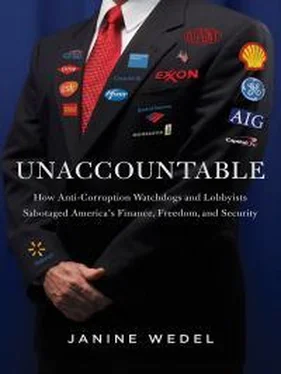58. Foreign influences were largely overlooked despite documentation at the time that development assistance and foreign aid can facilitate corruption. Some studies, monographs, and media reports documented cases in which aid spurred corruption (see, for instance, Robert Klitgaard, Tropical Gangsters: One Man’s Experience with Development and Decadence in Deepest Africa . New York: Basic Books, 1990).
With regard to the World Bank, although anti-corruption Bank programs did include audits of contracts and add oversight staff, the notion that corruption could be spurred in any substantial way from the outside did not, for the most part, figure into the Bank’s approach to studying corruption.
59. See, for example, World Bank, Helping Countries Combat Corruption: The Role of the World Bank. Washington, D.C.: World Bank, Poverty Reduction and Economic Management, 1997, p. 11.
60. Gary S. Becker, “To Root Out Corruption, Boot Out Big Government.” Business Week , January 31, 1994, p. 18.
Kalin S. Ivanov explains this view: “For Becker (1995) and many other economists, ‘the source of official corruption is the same everywhere: large government with the power to dispense many goodies to different groups.’ Therefore, smaller and more ‘businesslike’ government is ‘the only surefire way to reduce corruption’ (Becker, 1995) [Gary S. Becker, “If You Want to Cut Corruption, Cut Government,” Business Week , December 11, 1995, p. 26.].” (Kalin S. Ivanov, “The Limits of a Global Campaign Against Corruption,” Corruption and Development: The Anti-Corruption Campaigns, Sarah Bracking, ed. New York: Palgrave Macmillan, 2007, p. 34.)
61. Michael Johnston, Syndromes of Corruption: Wealth, Power, and Democracy. New York: Cambridge University Press, 2005, p. 6.
62. With respect to the first aid approach, for instance, a 1999 Bank program for the Europe and Central Asia region specifies: (a) “Economic policy reform (deregulation, tax simplification),” (b) “Civil service reform (moving to a professional, merit-based, well-paid civil service),” (c) “Public finance management (strengthening audit and procurement),” (d) “Legal and judicial reform (an independent and strong judiciary, development of the legal profession),” and (e) “Awareness building and public oversight (Ombudsman, client surveys, NGOs)” (World Bank, Anti-Corruption Program in the ECA Region. Washington, D.C.: World Bank Poverty Reduction and Economic Management, 1999, p. 2).
Regarding the second aid approach (shrinking opportunities for corruption), that idea is reflected in the World Bank’s institutional initiatives to reform the “performance” of the public sector, such as the recruitment, training, and promotion of public employees. This was one of two major areas of its anti-corruption work. (The other major area of anti-corruption work was public education.) (World Bank, Helping Countries Combat Corruption: The Role of the World Bank. Washington, D.C.: World Bank, Poverty Reduction and Economic Management, 1997, p. 8).
63. Privatization almost at any cost—at the expense of attention to creating regulatory and governance institutions as the backbone of a market economy and issues such as the potential for privatization-induced corruption—prevailed as a near religion among economists and many decisionmakers in the 1990s (Janine Wedel, Collision and Collusion: The Strange Case of Western Aid to Eastern Europe . New York: Palgrave, 2001, pp. 49-50).
The anti-corruption industry and the privatizers of the 1990s pursued a mutual goal—privatization—with limited debate in the standard economics literature. Key architects of Russian privatization schemes, including Maxim Boycko, a central player, and Harvard professor Andrei Shleifer, argued that privatization would diminish corruption as well as increase efficiency (Maxim Boycko, Andrei Shleifer, and Robert W. Vishny, “A Theory of Privatization.” The Economic Journal, vol. 106, no. 435, March 1996, pp. 309-319; see also Maxim Boycko, Andrei Shleifer, and Robert W. Vishny, Privatizing Russia. Cambridge, MA: MIT Press, 1995). A shrunken state sector would simply not have as many opportunities to extract bribes or concessions (Shleifer and Vishny 1998). (This idea has roots in Bhagwati’s analysis of the “welfare consequences” of DUP [directly unproductive, profit-seeking] activities [Jagdish N. Bhagwati, “Directly unproductive profit-seeking (DUP) activities.” Journal of Political Economy, vol. 90. No. 5, October 1982, pp. 988-1002]; see also Jagdish N. Bhagwati and T. N. Srinivasan, “The welfare consequences of directly unproductive profit-seeking (DUP) lobbying activities: price versus quantity distortions.” Journal of International Economics, vol. 13, issues1-2, 1982, pp. 33-44.) For further detail, see Janine R. Wedel, “Rethinking Corruption in an Age of Ambiguity.” Annual Review of Law and Social Science, vol. 8, December 2012, pp. 463-470.
64. This is the case not only with regard to former Soviet and Eastern Bloc countries (see, for example, Elizabeth Harrison, “The ‘Cancer of Corruption.’” Between Morality and Law: Corruption, Anthropology and Comparative Society , Italo Pardo, ed. Aldershot, U.K.:Ashgate, 2004, p. 143).
65. See, for example, Svetlana P. Glinkina, “Privatizatsiya and kriminalizatsiya: how organized crime is hijacking privatization.” Demokratizatsiya, vol. 2, 1994, pp. 385-391; Gernot Grabher and David Stark, eds., Restructuring Networks in Post-Socialism: Legacies, Linkages, and Localities , Oxford: Oxford University Press, 1997; Anthony Levitas and Piotr Strzałkowski, “What does ‘Uwłaszczenie Nomenklatury’ (Propertisation of the Nomenklatura) really mean?” Communist Economies, vol . 2, 1990, pp. 413-416; Domenico Mario Nuti, “Mass privatisation: costs and benefits of instant capitalism.” Discussion Paper, Series No. 9, CIS-Middle Europe Centre, London Business School, 1994; Louise Shelley, “Privatization and crime: the post-Soviet experience.” Journal of Contemporary Criminal Justice, vol. 11, 1995, pp. 244-245; David Stark, “Privatization in Hungary: from plan to market or from plan to clan?” East European Politics & Societies, vol. 4, 1990, pp. 351-392; David Stark and Lazlo Bruszt, Postsocialist Pathways: Transforming Politics and Property in East Central Europe . Cambridge: Cambridge University Press, 1998.
66. Although the ideology of privatization reigned supreme, the view from the ground revealed the rearranging of state assets into might-be-state, might-be-private entities, often with powerful players—themselves mergers of official and private power—at the helm (for instance, Antoni Kamiński, “The new Polish regime and the spector of economic corruption.” Presentation at Woodrow Wilson International Center for Scholars, April 3, 1996; Antoni Kamiński, “Corruption under the post-communist transformation.” Polish Sociological Review, vol. 2, 1997, pp. 91-117, 1997; Antoni Kamiński and Joanna Kurczewska, “Main actors of transformation: the nomadic elites,” Eric Allardt and Wlodzimierz Wesolowski, eds., The General Outlines of Transformation . Warsaw: IFIS PAN 1994, pp. 132-153; Janine R. Wedel, “Corruption and organized crime in post-communist states: new ways of manifesting old patterns.” Trends in Organized Crime, vol. 7, 2001, pp. 3-61; Janine R. Wedel, “Blurring the state-private divide: Flex organisations and the decline of accountability,” in Max Spoor, ed., Globalisation, Poverty and Conflict: A Critical Development Reader . Dordrecht, Netherlands/Boston: Kluwer Academic, 2004, pp. 217-235).
Читать дальше












